HR professionals handle a lot. From disputes to feedback, investigations to follow-ups—it’s a fast-paced world. One of their biggest pain points? Managing employee relations (ER) cases from start to finish. That’s where HR case management tools come to the rescue. These tools make life easier, faster, and more consistent.
Let’s break it down. We’ll explore how these tools help HR teams standardize the employee experience, ensure fairness, and keep everything organized. And don’t worry—we’ll keep it fun and simple!
What is HR Case Management?
Think of it like this. Each time an employee has an issue—maybe it’s a complaint, a question about leave policies, or a concern about a manager—that’s a “case.” HR needs a way to track it, respond, and resolve it in a timely, fair, and compliant way.
Before these tools, there were emails, spreadsheets, sticky notes (yes, really), and crossed fingers. That led to gaps, delays, and big headaches.
HR case management tools help HR teams track every step of a case from intake to resolution.
Why Standardization Matters
Imagine you and a coworker have the same issue, but HR handles yours quickly and justly—and theirs? Total mess.
Unfair, right? That’s why consistency is key. Standardization keeps the process reliable for everyone, every time.
Here’s what standardized ER with a case management tool can look like:
- Intake: Simple forms for employees to report issues directly.
- Assignment: HR assigns the right person to the case fast.
- Investigation: Tools to collect notes, interviews, and documents in one spot.
- Resolution: Clearly documented outcomes and next steps.
- Follow-up: Automatic reminders to check in or review progress later.
All in one tool. All in one place. Simple, smart, secure.
Main Features of HR Case Management Tools
Modern case management tools are loaded with useful features. Let’s highlight a few that help HR teams shine:
- Centralized Dashboard: See every open case, due date, and status at a glance.
- Templates: Pre-built templates standardize responses and documentation.
- Automation: Set rules for assigning cases or sending alerts.
- Analytics: Get insights into trends, hot spots, and fixable issues.
- Security: Lock it down tight with access controls and audit trails.
These tools are built for speed, accuracy, and professionalism.

Benefits You’ll Love
Still wondering, “Is this really worth it?” Let’s list the top wins you get with HR case management tools:
1. Consistency and Fairness
People want to be treated fairly. With standardized processes, every case gets the same care and attention. And that builds trust.
2. Efficiency and Speed
No more searching in inboxes or digging through files. Everything’s in one place. Responses are faster, and problems are solved quicker.
3. Better Decision-Making
Data is powerful. With built-in analytics, leaders can spot trends—like departments with frequent complaints—and take action.
4. Compliance and Documentation
Ever had to pull together all the steps taken in a sensitive case for legal reasons? With a robust tool, every step is time-stamped and stored securely.
5. Happier HR Teams
Less chaos = less stress. Your HR team will thank you for adopting tools that lighten the load.
From Intake to Resolution: A Real-Life Flow
Let’s walk through a simple employee case using a case management tool:
- John reports bullying via the employee portal.
- An HR representative is automatically assigned.
- Notes, interviews, and evidence are added into the case file.
- A resolution is decided and communicated to both parties.
- Two weeks later, HR is reminded to check in with John.
Now imagine doing all that through email and sticky notes. Yikes.
Integrations Make It Even Better
A good HR case management tool doesn’t work alone. It plays nice with others. Look for tools that integrate with:
- HRIS (Human Resources Information Systems)
- Payroll platforms
- Email/calendar systems
- Slack or Teams messaging tools
This way, everything talks to each other. Less jumping between tabs, more getting stuff done.

Getting Started is Easier Than It Sounds
Worried about switching from your old ways to something new? Don’t be. Many top tools are:
- Cloud-based: No heavy IT install needed.
- User-friendly: Drag, drop, click, done.
- Scalable: Whether you’re a 20-person startup or a 10,000-employee company, there’s a fit.
- Supported: Great tools come with great support staff to help train your team.
The switch pays off fast. Your processes get smoother, and your people get happier.
How to Choose the Right Tool
Shopping around? Make sure to ask these questions:
- Is it easy to use?
- Can it scale with our company?
- Does it keep data safe and compliant?
- What reporting and analytics does it offer?
- Can it integrate with our existing systems?
- What real-life case studies or customer reviews exist?
Bonus points if it makes your HR team smile during demos!
Wrap-Up: It’s Time for a Smarter Way
Employee relations are serious. But managing them doesn’t have to be overwhelming.
With the right HR case management tool, you can:
- Stay organized
- Standardize your processes
- Create better, faster, and fairer outcomes
- Free up time to focus on people
It’s not about checking a box. It’s about building a workplace where people feel heard, respected, and valued.
So if you’re still juggling files, emails, and sticky notes—it’s time for a change. Your employees (and your HR team) will thank you.





